Menu

There is so much information and many skills and techniques that parents need to be equipped with to support them in their role supervising learner drivers. It is about learning how to manage an ever changing environment, so they learn how to make good decisions early, as a driver.
It is about understanding how every decision that want to make, is the exact opposite of what they need to make. This is why all drivers create their own crashes.
This environment has changed so much from when many of us got our drivers licences.
Essentially everything they want to do, is the exact opposite of what they need to do, and they is why they beleive they are champions, and you are terrified!

2. Industry statistics, show an increase of 30 times their pre licence accident rate (3000% increase in risk) is simply showing that with the current system, the approach and emphasis is misplaced for the outcome. This is why they are overrepresented in accidents, injuries and fatalities.
Keys to Drive program states that parents should sit back and let the learner driver work it out for themselves, if that was the case, we would not have a road toll, as that is how WE ALL learned how to drive!

What the graph is really showing is the approach and emphasis of 1 hour driving lessons to pass the driving test, is not actually preparing them as drivers! Driving schools are doing everything but actually teaching the ART of DRIVING.
In no other industry, or workplace, would a supervisor be authorised, with no appropriate experience, qualifications or assessment? But this happens to every parent with a learner driver. Who prepares you, to teach and prepare them?
The brain picks and chooses what it thinks it should see, based on what it expects to see there. This can also be affected by colours, wording and packaging, not being what we are looking for.

If we have this much trouble with this inanimate, non threatening environment, how much challenge is there when we accelerate the information with the speed that comes with driving and the complexity of multiple traffic flows on the road?
We all have three fields of vision, 1. Close range – Reading, 2. Tunnel and 3 Peripheral. Unfortunately when people drive, they want to use close range to identify threats whereas they need to use peripheral vision to identify risks for a better outcome. and strategy.
So when you are teaching your learner driver, teach them to look at the big picture. Treat the windows and windscreen like a 3D cinema, looking through to the furthest point, not one car or two or three ahead, but where the road actually goes.
5. Their natural reactions are the exact opposite of what is required for good driving
It is called embodied cognitive skills, muscle memory. For each person it is how we make threat and hazard avoidance decisions in our natural environment. It is when we walk or run it is how we manage all that could put us at risk.

When we drive, we introduce speed, unfortunately our brains cannot process speed. So every decision a new driver wants to make, that kept them safe and alive for their first 16 years, happens to be the opposite of what they need to make. This is what creates stress, frustration and conflict and therefore dangerous situations.
This is the hard part and why the idea of just a few random driving lessons fails our young people badly.
There is a process to fix this, to create a new decision making process and it encompasses the following techniques:
6. Why they are overrepresented in post licence accidents and statistics
If we know their decision making process is reactive, as it is based on our natural environment – such as walking and running, then we know…….
That driver training is the creating of a new “Embodied Cognitive processes” that enables the student to buy time, slowing down the window of information so they see the full picture. This changes their decision making process from Reactive to Proactive.
7. Seating and postural stability
This makes us part of the car

8. That our eyes tell us lies
If the driver has poor balance, little postural stability and poor steering technique, they will use the steering wheel as a brace / support. This will cause them to lean their head into a corner.
For every 100 meters they are looking down the road, their eyes can give misinformation, by up to three metres from where they believe they have placed the car, to where it is actually heading.
9. Teaching your learner is one of the highest risk activities you will ever undertake.
Yet with driving, parents often believe it is up to their teens to make the decision and accept responsibility for organising lessons, buying their first car.
Are they going to choose based on outcome or price?

Driving is the highest risk activity they will ever undertake. Crashes cause 66% of deaths among 17 to 20s.
A good driving school will
16/14 Macarthur pde Main Beach Q 4217
Via the web, phone or email or start your booking online below.
